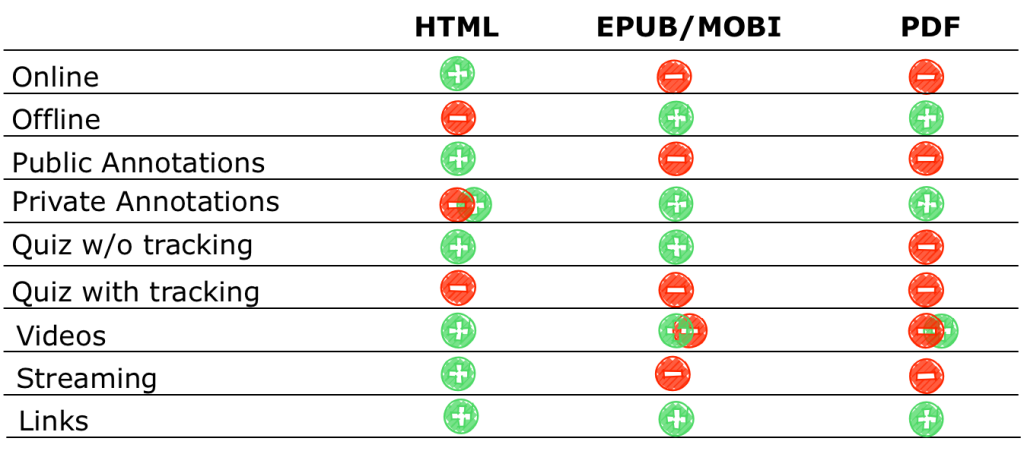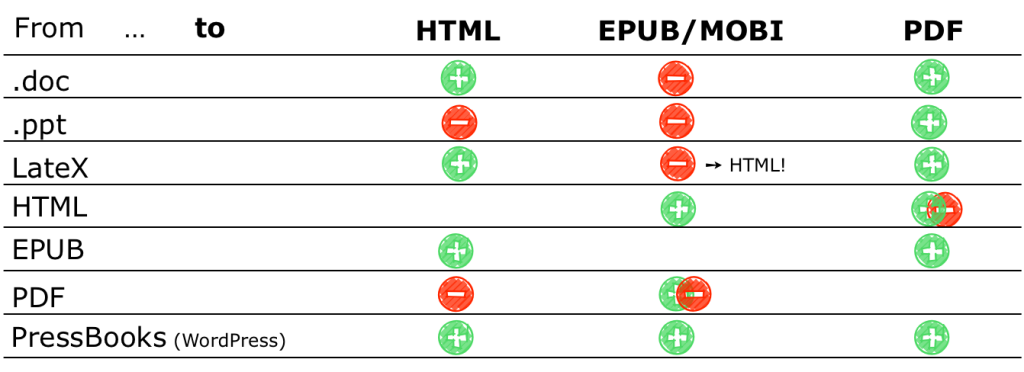If you’re reading this, we have established that you want more (videos, quizzes, simulations, annotation possibilities, embedded material,…) out of your lecture material! But how? The following simplified charts give you a quick overview of the different formats’ characteristics and are in parts the summary of the three previous chapters.
- Possibilities (Chart I)
- Acceptance (Chart II)
- Conversions (Chart III)
- Suggestion
Chart I – Possibilities
We want to cover everything (online, offline, quizzes, etc.)! And it is just not possible. If we look at the three formats HTML, EPUB/MOBI and PDF, we see that HTML, nowadays, offers you most.
If you integrate HTML or EPUB in a content/learning management system, tracking of students’ results becomes possible.
Chart II – Acceptance
Even though we think we live in the digital age, I can tell you that we are at a pre-infant state and many cool new things are still unavailable to the big public because they are just too complicated. How, when and what do I do with an eBook? Can I really take notes digitally? These are widely asked questions, and that’s okay.
There is no chart here because we have not conducted any surveys to find out more. What we know, is that PDF is widely accepted for almost anything and especially for lecture material. EPUB is more appealing to lecturers than students, and HTML is still a bit weird for everybody because nobody has had much experience with it. Acceptance is the last step towards change and it takes practice and time.
Chart III – Conversions
Maybe you already know what you want (“I want an eBook!”) and then you can just do that. But if you think about your students and the future of your material, you have to consider different formats and their conversion possibilities.
Today’s world is a mess! The following chart does not show clear cut possibilities. While it is possible to transform a PDF into an EPUB, it just may look terrible. And, EPUB is not EPUB. EPUB2 and EPUB3 are distant cousins from another decade. PDFs are easy but when you end up with a PDF, that is it. It is the end of your document. (Un)fortunately HTML is (not) XHTML and/nor HTML5 and… Still, we root for HTML because it is one of the least constraining for the future and has the most possibilities, and we also found Pressbooks. But more on that in the ‘Suggestion’ below.
Conversions of content from one format to another always means work. For some of the conversions, people have worked for us in advance and created software that makes it very easy to convert. As mentioned before, it may be easy to convert from one format to another but it may look terrible after the conversion, or it may have lost all pictures. The following chart shows you a circumspect attempt at which conversions are easy/possible/sensible and which are not.
In the last row of the chart, you see the format Pressbooks that presents you with HTML plus services (from a server) and can readily export an EPUB, MOBI and PDF.
.doc to EPUB is possible but depending on your formatting and structure, the result may be diverse.
Suggestion
We propose to lecturers and students to use eSkript. eSkript is HTML based (WordPress server) and it is mostly Pressbooks (WordPress plugin) that covers many of the functions we want. Additionally, WordPress has a vast number of other plugins for other wishes we may want to fulfil. At ETH Zurich it is available under eskript.ethz.ch. If you are reading this online, this is it! The next chapter is all about this.

